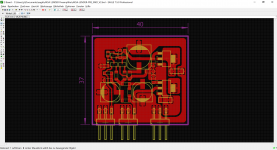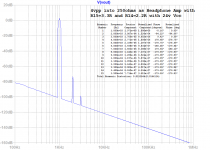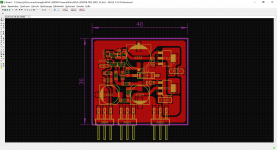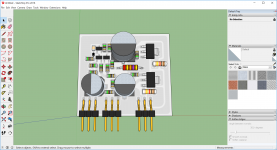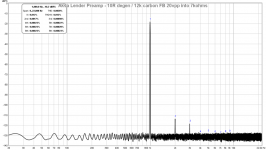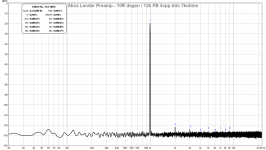OSCOns are nice for feedback shunt cap or for output coupling cap where low ESR gives better bass authority and minor leakage is not an issue. They are also nice for space constrained applications where dense volume is needed. I use them as output caps on my pocket class A amp because it lets me fit 2000uF in a tiny space with two units.
I agree that they are not needed for the 100uF 50v voltage reference filter caps here. Almost any through hole 100uF 50v cap here will work well and save quite a bit of money ($0.15 vs $1.75 for example). Through holes can be mounted on opposite side of SMT side to allow more flexible arrangements as I have done.
I agree that they are not needed for the 100uF 50v voltage reference filter caps here. Almost any through hole 100uF 50v cap here will work well and save quite a bit of money ($0.15 vs $1.75 for example). Through holes can be mounted on opposite side of SMT side to allow more flexible arrangements as I have done.
@xrk971
Why R10 carbon? or non inductive? Carbon as SMD resistor is very difficult to order!
MELF or MINIMELF enabling possibility to route signals under themself (starting standard size 1206) and IMHO they are a good choice for audio (from 0102(MMU) to 0207(MMB); SMD holder only for 0204(MMA)); also available from all distributors. Footprints are IPC compliant.
Remember, the metal core PCB doesnt allow vias.
@sottomano
I´ll check datasheets. Unfortunately, ELNA SILMIC SMD RVF (up to 10µ) or RVO/RVM types not yet available as small quantities order. Will check PANASONIC, RUBYCON and others.
JP
Why R10 carbon? or non inductive? Carbon as SMD resistor is very difficult to order!
MELF or MINIMELF enabling possibility to route signals under themself (starting standard size 1206) and IMHO they are a good choice for audio (from 0102(MMU) to 0207(MMB); SMD holder only for 0204(MMA)); also available from all distributors. Footprints are IPC compliant.
Remember, the metal core PCB doesnt allow vias.
@sottomano
I´ll check datasheets. Unfortunately, ELNA SILMIC SMD RVF (up to 10µ) or RVO/RVM types not yet available as small quantities order. Will check PANASONIC, RUBYCON and others.
JP
Attachments
You missed the revelation a page back. This was killer to find - almost had to swap out every part on board to duplicate the veroboard before I found it.
Here is FFT with metal film SMT:
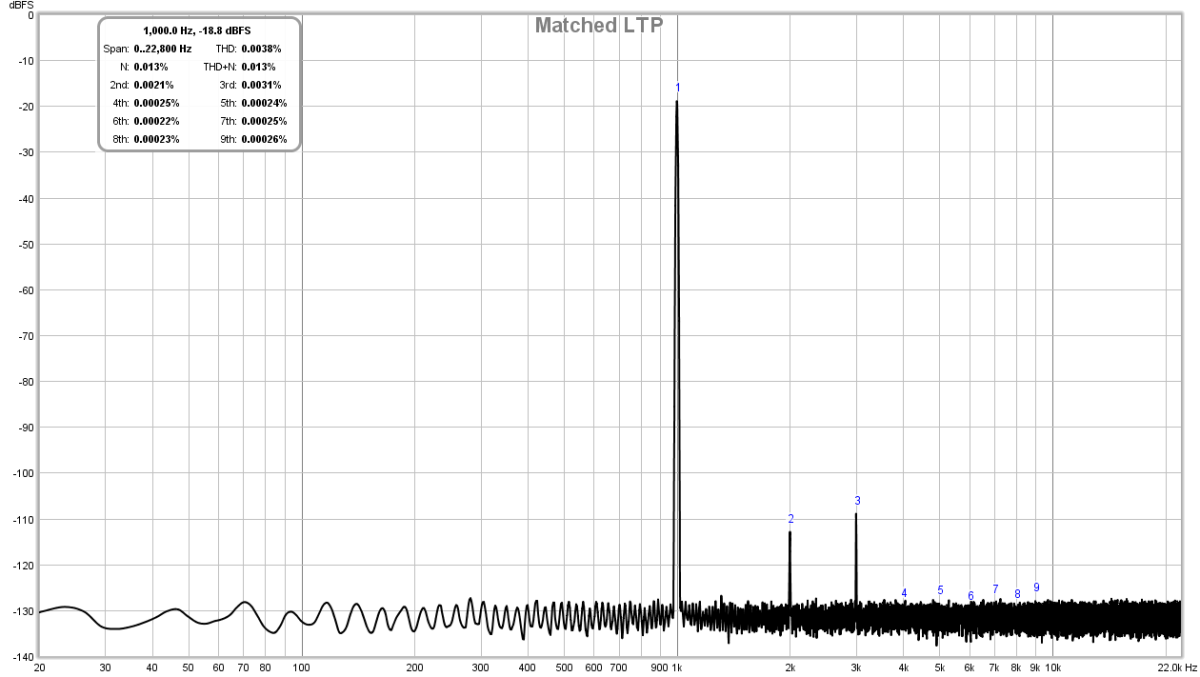
Here is carbon on R10 feedback resistor:
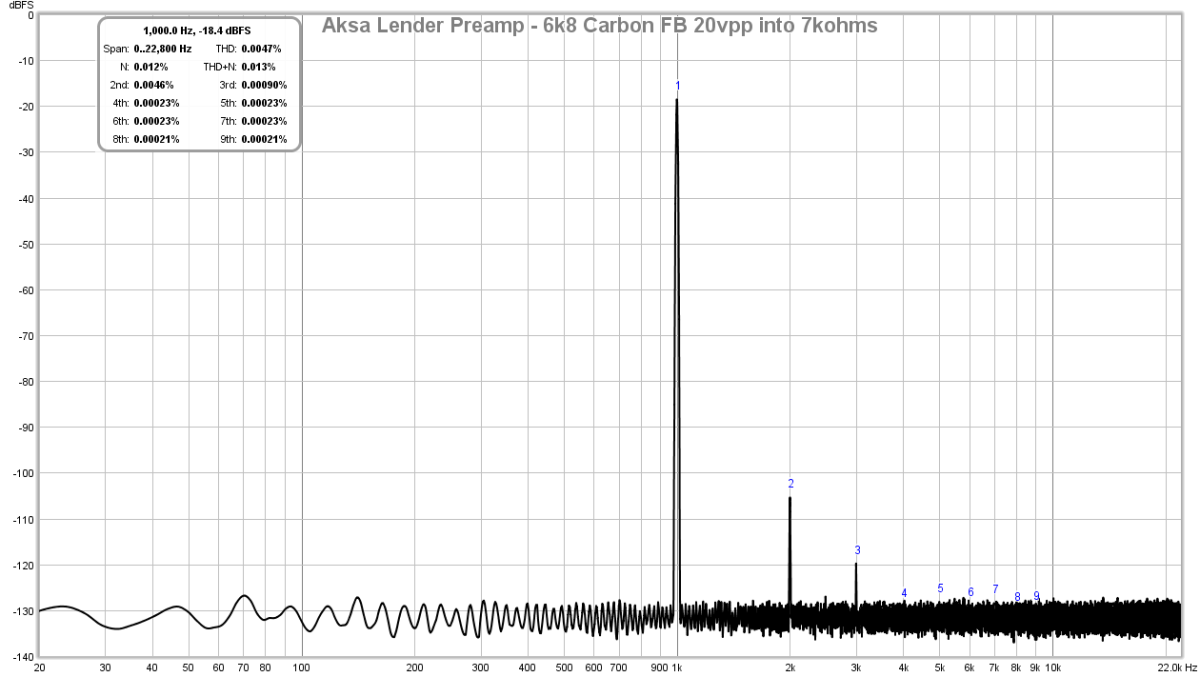
This confirms anecdotal reports that metal thin film resistors, when used in audio path, "sound harsh". It is extra sensitive in the feedback position. Matched LTP transistors hardly made any difference, and the difference it made was to reduce H2 even farther relative to H3.
You can take an axial carbon resistor and bend the legs to mount on 0812 SMT pad easy enough. Luckily, it is just this one resistor that needs to be carbon.
Here is FFT with metal film SMT:
Here is carbon on R10 feedback resistor:
This confirms anecdotal reports that metal thin film resistors, when used in audio path, "sound harsh". It is extra sensitive in the feedback position. Matched LTP transistors hardly made any difference, and the difference it made was to reduce H2 even farther relative to H3.
You can take an axial carbon resistor and bend the legs to mount on 0812 SMT pad easy enough. Luckily, it is just this one resistor that needs to be carbon.
Last edited:
There is one other trick this circuit can do if you make R15=3.3R and R14=2.2R and drop Vcc to 24v. You get a pretty nice headphone amplifier! Here it is driving 4vpp into 250ohm load:

This is for 72mA bias current and about 900mW dissipation in each of the output devices and CCS MOSFET (still within spec).
Also, change output cap to bigger value if using lower impedance headphones. I put in 2200uF in sim but probably 470uF is enough for 250 ohm phones.
This is for 72mA bias current and about 900mW dissipation in each of the output devices and CCS MOSFET (still within spec).
Also, change output cap to bigger value if using lower impedance headphones. I put in 2200uF in sim but probably 470uF is enough for 250 ohm phones.
Attachments
Last edited:
carbon 1/4W replaced.
100µ --> PANASONIC FC (leakage 0.01CV), others stay OSCON.
All other parts (input/output caps, volume potentiometer, cap-multiplier, CRCRC) on mainboard (in progress).
JP
100µ --> PANASONIC FC (leakage 0.01CV), others stay OSCON.
All other parts (input/output caps, volume potentiometer, cap-multiplier, CRCRC) on mainboard (in progress).
JP
Attachments
Not to Steel X fire here
I have been playing with different manufactured feedback resistors in my amplifier,they can make huge differences in sound for sure
I just did install some carbon films and you can clearly hear the third harmonic is lessened, this really can fool you into thinking you have less distortion for sure
I wonder how long for resistors to break in
I have been playing with different manufactured feedback resistors in my amplifier,they can make huge differences in sound for sure
I just did install some carbon films and you can clearly hear the third harmonic is lessened, this really can fool you into thinking you have less distortion for sure
I wonder how long for resistors to break in
Resistor choice in the FB path
X that is no doubt a good observation and well worth to keep in mind, may we know exactly what brand, power rating and tempco the mentioned resistors were of, thanks.
This confirms anecdotal reports that metal thin film resistors, when used in audio path, "sound harsh". It is extra sensitive in the feedback position. Matched LTP transistors hardly made any difference, and the difference it made was to reduce H2 even farther relative to H3.
X that is no doubt a good observation and well worth to keep in mind, may we know exactly what brand, power rating and tempco the mentioned resistors were of, thanks.
Last edited:
The SMT 0805 5% thick metal film resistor was unbranded from an "assortment pack" (I did not have my usual Yageo 1% 0805 in that particular value. ) The carbon film was also from an assortment pack and unbranded. Maybe I will buy a set of nice 2% name brand carbon resistors from Stackpole the next time I order from Mouser or Digikey.
^ Thanks for a quick reply X!
This is an interesting topic indeed, I don't dismiss or suspect in anyway the claims and anecdotes given in this matter, rather more measurements is needed, I just wish I had some gears up and running I would be happy to share as mush as I can right here.
btw, here's one thing more you could try before shopping new resistors, use 4 of those metal films configured like: (series + series) paralleled with another (series + series) chain, we now have the same resistance but the power handling goes up 4 times and eventual voltage dependent anomalies and temp.co should also decrease, this CAN have an impact too, but will it be for the better or the worse?
And the same test could of course be performed with the carbon resistors as well...
This is an interesting topic indeed, I don't dismiss or suspect in anyway the claims and anecdotes given in this matter, rather more measurements is needed, I just wish I had some gears up and running I would be happy to share as mush as I can right here.
btw, here's one thing more you could try before shopping new resistors, use 4 of those metal films configured like: (series + series) paralleled with another (series + series) chain, we now have the same resistance but the power handling goes up 4 times and eventual voltage dependent anomalies and temp.co should also decrease, this CAN have an impact too, but will it be for the better or the worse?
And the same test could of course be performed with the carbon resistors as well...
Very good result, X.
If you can change the gain about 2x - 4x with same result, I think it would be a useful pre-amp. We can put a volume control before this pre-amp.
And then build a good voltage regulator for it.
I did this test just for you Bimo. Feedback resistor is now 12k carbon (5% no-name brand from China), so about 2x the gain of the previous setup. I changed degeneration resistors on LTP to 10R (1% 0805 metal film Yageo from Digikey). Driving same 20vpp into 7kohm load, the THD is now only 0.002% and H2 is still higher than H3 but not by 15dB anymore. However, I suspect that this is still a very nice result that many would find transparent and very usable.
The lack of any orders of distortion above H3 is very nice result - a fresh breath of air compared to a forest of spikes often seen on complex designs. I will spend some time listening to it like this to see how I like it. The last config, is probably still going to reign king in my book, but I am trying to keep an open mind. 0.002% THD is nothing to be ashamed about I think (to put it in perspective, it is about the same as the least significant bit in a 16-bit CD recording).
Finally, as a typical line level preamp duties pushing 4vpp into 7kohm load gets 0.0011%THD with H2 only 5.7ppm and H3 4.5ppm, for regular use on power amps with some gain, these are going to be the max signal levels coming out of this preamp, and probably into n easier load than 7kohms (47k to typically):
So, this is a nice result as well I think.
Attachments
Last edited:
XRK, conventional 'old wisdom/conjecture' has it that distortions below the 0.1% mark are essentially inaudible.
You are achieving 100x better distortion performance which should be totally inaudible according to 'theory' and then playback through transducers distorting at the 0.1% level which in theory should totally mask any amplifier distortions.
Yet, you are stating that relative changes between 2nd and 3rd harmonic down at the -110dB level are audible and distinctly change the 'character' of the reproduced sound.
Do I have this correct ?.
If so could you describe these subjective differences please ?.
Dan.
You are achieving 100x better distortion performance which should be totally inaudible according to 'theory' and then playback through transducers distorting at the 0.1% level which in theory should totally mask any amplifier distortions.
Yet, you are stating that relative changes between 2nd and 3rd harmonic down at the -110dB level are audible and distinctly change the 'character' of the reproduced sound.
Do I have this correct ?.
If so could you describe these subjective differences please ?.
Dan.
XRK, conventional 'old wisdom/conjecture' has it that distortions below the 0.1% mark are essentially inaudible.
You are achieving 100x better distortion performance which should be totally inaudible according to 'theory' and then playback through transducers distorting at the 0.1% level which in theory should totally mask any amplifier distortions.
Yet, you are stating that relative changes between 2nd and 3rd harmonic down at the -110dB level are audible and distinctly change the 'character' of the reproduced sound.
Do I have this correct ?.
If so could you describe these subjective differences please ?.
Dan.
We are talking about very low levels indeed, but the character of the profile makes a difference, even though it is down in the noise. In blind ABX tests (I don't have the references), amps with dominant 2nd order and monotonically decreasing higher orders sound better. Lack of 5th, 7th, 9th harmonic give a more "natural" less mechanical sound. I think amps with higher order distortions, even if they are below 0.1% may sometimes be characterized as "fatiguing." But I think I will leave it at the design goal for me is to have a dominant 2nd order and lower 3rd order and monotonically decreasing higher orders. That is the goal no matter what the absolute level of distortion is.
conventional 'old wisdom/conjecture' has it that distortions below the 0.1% mark are essentially inaudible.
You are achieving 100x better distortion performance which should be totally inaudible according to 'theory' and then playback through transducers distorting at the 0.1% level which in theory should totally mask any amplifier distortions.
I suspect the nature of distortions of the electronics vis a vis transducers are rather different, and that the ear finds electronic distortions far more objectionable than those of the transducers, particularly speakers which are electro-mechanical.
Put another way, 10% distortion of a speaker is very different to 0.05% dominated by higher odd order harmonics created in the electronics.
HD
Thanks for your answer.We are talking about very low levels indeed, but the character of the profile makes a difference, even though it is down in the noise.
Agreed, the harmonics profile is important when at higher (directly audible) levels.
The 'surprising' part is that this harmonics profile is still discernible even when down into the -110dB noise.....testimony to the ear/brain ability to 'pull signal out of noise'.
Yes.In blind ABX tests (I don't have the references), amps with dominant 2nd order and monotonically decreasing higher orders sound better. Lack of 5th, 7th, 9th harmonic give a more "natural" less mechanical sound.
Open loop amps may have relatively high distortion overall level, but generally with the 'desired' monotonically decreasing harmonics profile.
IME these amplifers sound 'friendly' and engaging, and the overall distortion adding 'dirt/masking' but this does not kill the party and the ear can 'ignore' it.
Yes, there were plenty of high feedback 80's/90's amps that quoted low THD.I think amps with higher order distortions, even if they are below 0.1% may sometimes be characterized as "fatiguing." But I think I will leave it at the design goal for me is to have a dominant 2nd order and lower 3rd order and monotonically decreasing higher orders. That is the goal no matter what the absolute level of distortion is.
Sure they sounded 'clean and detailed', but ultimately drive the listener out of the room with sound that 'just ain't right'.
This 'machine sound' adds false sheen and brightness, but more disturbingly causes a dynamically changing shimmy/shimmer and 'busyness' in the overall presentation.
You asked about my interest in your/Dean's circuit.
I like it for the reasons you do.
My application and question was regarding driving amps or volume control pots with 10k or less loading.
A balanced version could be very useful in a PA system as the final send to FOH amp rack.
Amplifiers in addition to adding harmonic profile can also act as a filter of sorts and can 'undo' upstream errors.....a bit like cables subtly 'modifying' sound throughput.
You solution featuring low parts count/cost is appealing, and by your reports worth a try.
Dan.
I did this test just for you Bimo.
So, this is a nice result as well I think.
Thank you, X. Very nice result. This is stable for gain 2x.
I think you should use load about 10K || 1nF, to see if stable drive capacitive load. May be a 47 Ohm resistor in output help the stability.
Lack of 5th, 7th, 9th harmonic give a more "natural" less mechanical sound. I think amps with higher order distortions, even if they are below 0.1% may sometimes be characterized as "fatiguing."
I agree.
But not all people can hear the different
For me, harmonic profile is first than THD is second. But if we can make lower THD with good harmonic profile, why not?
- Home
- Source & Line
- Analog Line Level
- AKSA's Lender Preamp with 40Vpp Output
